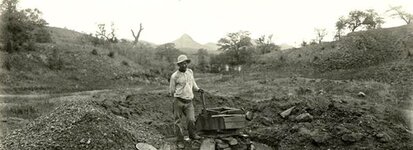Duckshot
Silver Member
- Sep 8, 2014
- 4,455
- 9,643
- Primary Interest:
- All Treasure Hunting
Anybody here ever build or use a rocker box?
What size were the riffles?
I got an older paperback book that has photos of Edwin P Morgan and his wooden rocker box , about 1965. Book has plans for a rocker box which gives dimension of 1" high riffles for a 14" wide rocker.
If there is a logical idea on how to figure optimal riffle height, or if anyone can give their opinion on how riffle height or spacing might change how materials flow through a rocker, I would very much like to listen. Thanks.
What size were the riffles?
I got an older paperback book that has photos of Edwin P Morgan and his wooden rocker box , about 1965. Book has plans for a rocker box which gives dimension of 1" high riffles for a 14" wide rocker.
If there is a logical idea on how to figure optimal riffle height, or if anyone can give their opinion on how riffle height or spacing might change how materials flow through a rocker, I would very much like to listen. Thanks.


 Won't be so bad once I get my new shop built, but it's too dang cold working out in the sub-zero temps with wind!!
Won't be so bad once I get my new shop built, but it's too dang cold working out in the sub-zero temps with wind!!




